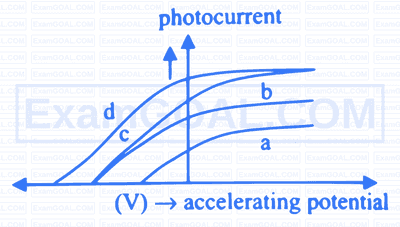Let $E_c$ and $E_p$ represents kinetic energy of electron and photon respectively. If de-Broglie wavelength of a photon is twice the de-Broglie wavelength of an electron then $E_p / E_c$ is (speed of electron $=\mathrm{C} / 100$ where C is the velocity of light)
The graph shows the variation of photocurrent with anode potential for four different radiations. Let $\mathrm{I}_{\mathrm{a}}, \mathrm{I}_{\mathrm{b}}, \mathrm{I}_{\mathrm{c}}$ and $\mathrm{I}_{\mathrm{d}}$ are intensities and $\mathrm{f}_{\mathrm{a}}, \mathrm{f}_{\mathrm{b}}, \mathrm{f}_{\mathrm{c}}$ and $\mathrm{f}_{\mathrm{d}}$ be the frequencies for the curves $\mathrm{a}, \mathrm{b}, \mathrm{c}$ and d respectively, then

The wavelength ' $\lambda$ ' of a photon and the deBroglie wavelength of an electron have same value. the ratio of kinetic energy of the electron to the energy of a photon is
( $\mathrm{m}=$ mass of electron, $\mathrm{c}=$ velocity of light, $\mathrm{h}=$ Planck's constant)